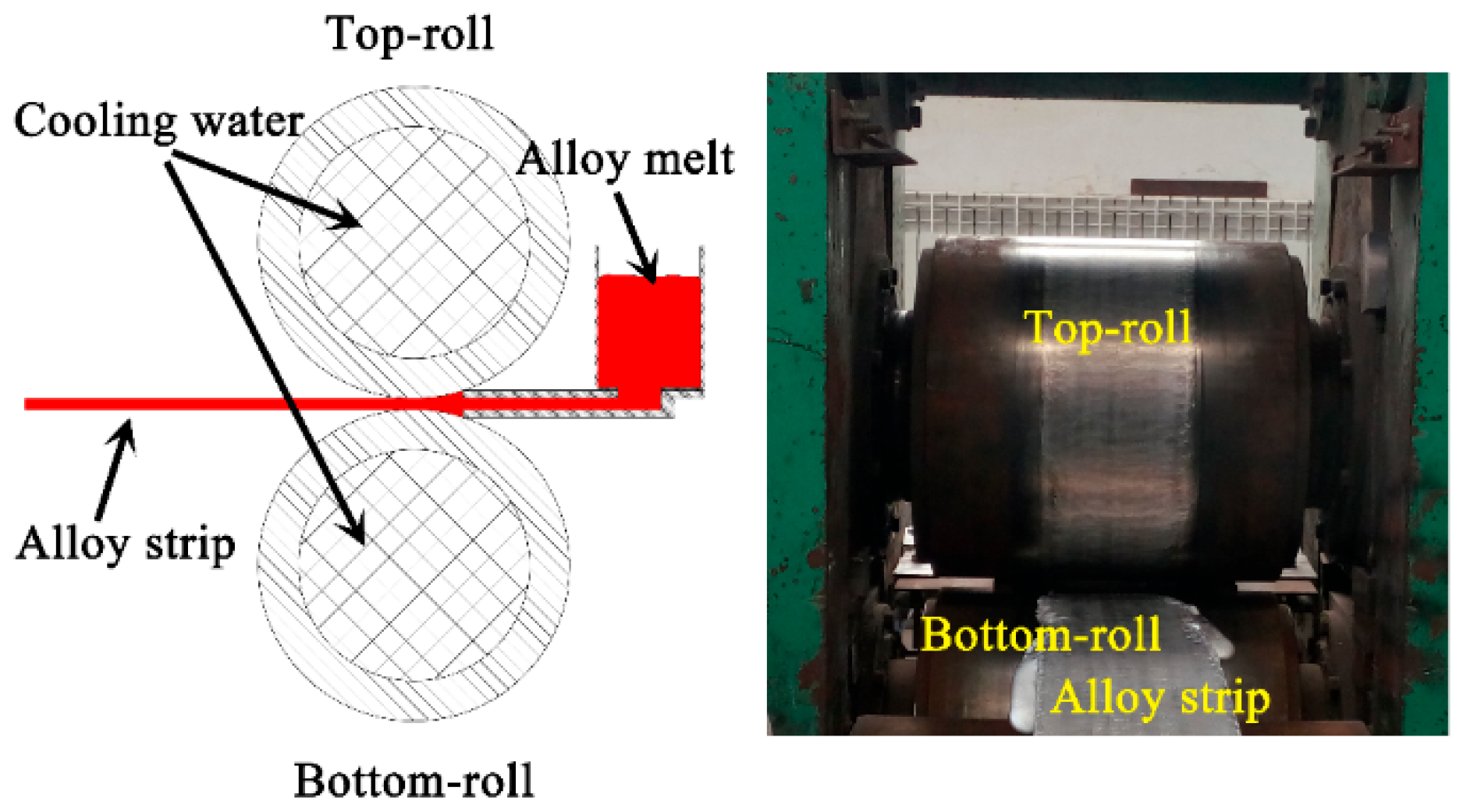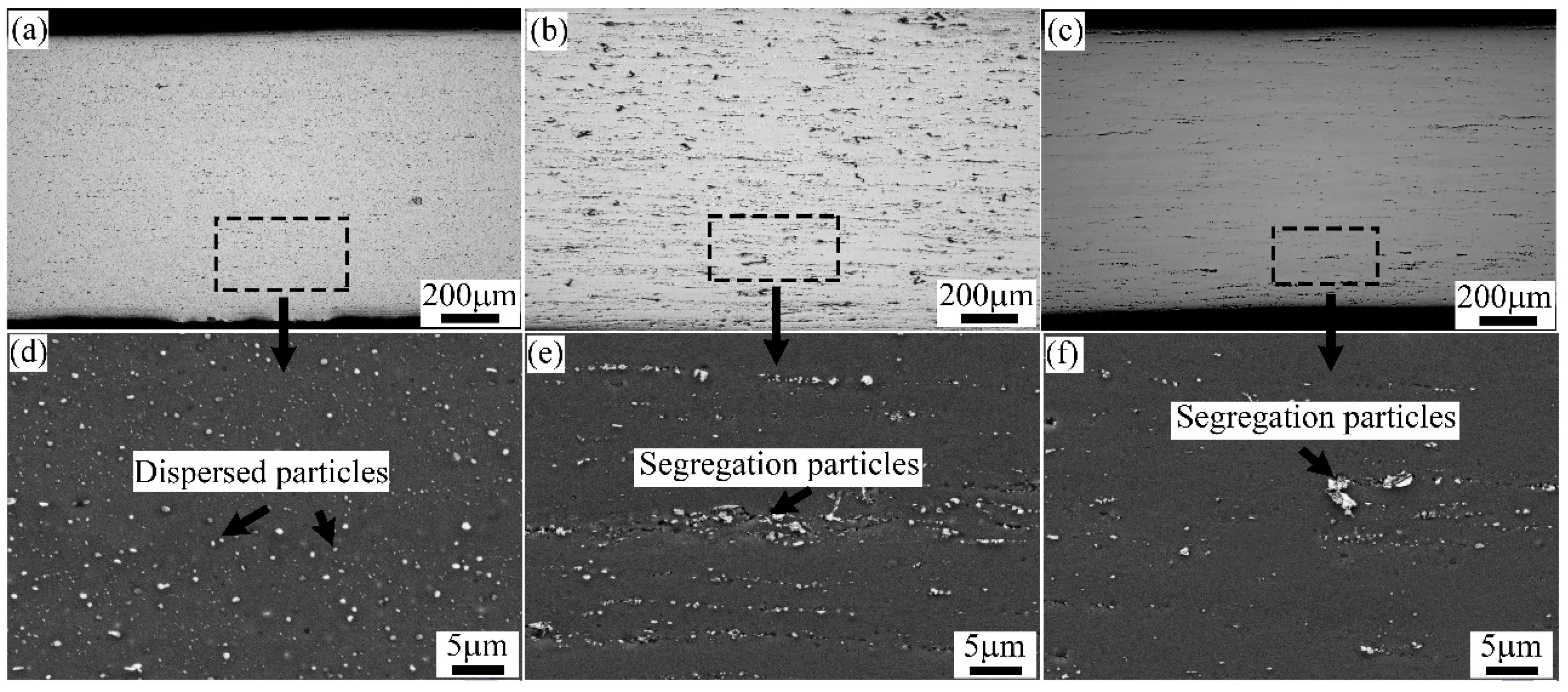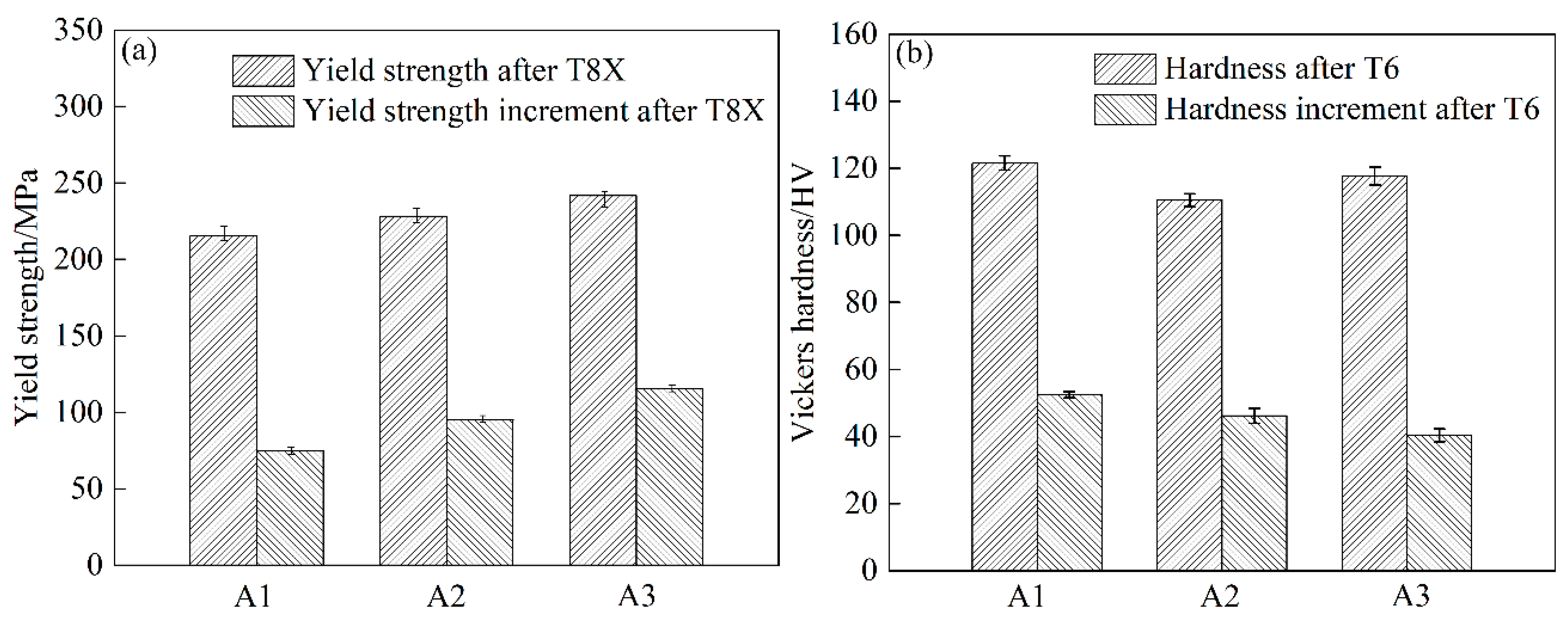Microstructure, Precipitates Behavior, and Mechanical Properties of Age-Hardened Al-Mg-Si Alloy Sheet Fabricated by Twin-Roll Casting
Abstract
1. Introduction
2. Materials and Methods
3. Results
3.1. Second Particles
3.2. Microstructure and Texture
3.3. Precipitation Behavior
3.4. Mechanical Properties
4. Discussion
5. Conclusions
- (1)
- The size of recrystallized grains for the DC casting alloy was marked by finely dispersed particles. With the segregated particles formed in TRC alloy, more coarse particles acted as nucleate particles to increase the recrystallization nucleation rate and dramatically decrease the recrystallized grain size.
- (2)
- Uniformly dispersed second particles resulted in the strong Cube and R texture formed after solution treatment. The value of r was low due to the high volume fraction of the Cube texture for DC casting alloy. A large number of segregation particles and coarse second phase particles formed in the TRC alloy resulted in a significant PSN effect. The typical CubeND texture accompanied by the P texture made the value of r higher.
- (3)
- When providing sufficient supersaturated solute atoms, more GP zones formed in the TRC alloy during T8X treatment. The strength of the TRC alloy was higher than that of the DC casting alloy. The ability of paint-bake hardening for the TRC alloy was better than DC casting alloy.
- (4)
- The number density and volume fraction of the β″ phase were highest for the DC casting alloy. A few segregation particles that remained in the alloy decreased the concentration of supersaturated atoms, resulting in the hardness of TRC alloy being lower compared to DC casting alloy.
Author Contributions
Funding
Institutional Review Board Statement
Informed Consent Statement
Data Availability Statement
Acknowledgments
Conflicts of Interest
References
- Hirsch, J.; Al-Samman, T. Superior light metals by texture engineering: Optimized aluminum and magnesium alloys for automotive applications. Acta Mater. 2013, 61, 818–843. [Google Scholar] [CrossRef]
- Miller, W.S.; Zhuang, L.; Bottema, J.; Wittebrood, A.J.; De Smet, P.; Haszler, A.; Vieregge, A. Recent development in aluminium alloys for the automotive industry. Mater. Sci. Eng. A 2000, 280, 37–49. [Google Scholar] [CrossRef]
- Li, Y.; Li, S.; Wei, B.; Xu, J.; Lian, J.; Xu, G.; Wang, Z. Microstructural evolution and properties of electromagnetic cast-rolled novel Al–Li alloy under different heat treatment procedures. J. Mater. Res. Technol. 2022, 16, 864–878. [Google Scholar] [CrossRef]
- Sun, K.M.; Li, L.; Chen, S.D.; Xu, G.M.; Chen, G.; Misra, R.D.K.; Zhang, G. A new approach to control centerline macrosegregation in Al–Mg–Si alloys during twin roll continuous casting. Mater. Lett. 2017, 190, 205–208. [Google Scholar] [CrossRef]
- He, C.; Li, Y.; Li, J.; Xu, G.; Wang, Z.; Wu, D. Effect of electromagnetic fields on microstructure and mechanical properties of sub-rapid solidification-processed Al–Mg–Si alloy during twin-roll casting. Mater. Sci. Eng. A 2019, 766, 138328. [Google Scholar] [CrossRef]
- Lu, B.; Li, Y.; Wang, Y.; Qian, X.; Xu, G.; Wang, Z. Effect of second-phase particle evolution in a twin-roll-casted Al-Mg-Si alloy on recrystallization texture and mechanical anisotropy. Mater. Charact. 2021, 176, 111038. [Google Scholar] [CrossRef]
- Li, S.; Wei, B.; Yu, C.; Li, Y.; Xu, G.; Li, Y. Evolution of microstructure and properties during homogenization of the novel Al–Li alloy fabricated by electromagnetic oscillation twin-roll casting. J. Mater. Res. Technol. 2020, 9, 3304–3317. [Google Scholar] [CrossRef]
- Wang, B.; Liu, X.; Zhu, Y.; Ma, C.; Qiu, F.; Zhao, Q.; Jiang, Q. The Effect of Mg/Si Ratio on the Microstructure and Tensile Properties of Twin-Roll-Casting Al–Mg–Si Alloys. Mater. Charact. 2022, 191, 112146. [Google Scholar] [CrossRef]
- Sun, Y.; Zhang, B.; Xu, Z.; Wang, H.; Li, S.; Tian, S. Microstructure evolution and recrystallization behavior of hot rolled AA6061 twin-roll casting plate with different manganese contents. J. Alloys Compd. 2022, 918, 165618. [Google Scholar] [CrossRef]
- Liu, X.; Wang, C.; Zhang, S.; Song, J.; Zhou, X.; Zha, M.; Wang, H. Fe-bearing phase formation, microstructure evolution, and mechanical properties of Al-Mg-Si-Fe alloy fabricated by the twin-roll casting process. J. Alloys Compd. 2021, 886, 161202. [Google Scholar] [CrossRef]
- Wang, X.; Ma, P.; Meng, Z.; Zhang, S.; Liu, X.; Wang, C.; Wang, H. Effect of trace Cr alloying on centerline segregations in sub-rapid solidified Al–Mg–Si (AA6061) alloys fabricated by twin-roll casting. Mater. Sci. Eng. A 2021, 825, 141896. [Google Scholar] [CrossRef]
- Matsuda, K.; Ikeno, S. Microstructure and Nano-Segregation of Cu in Al–Mg–Si–Cu Alloys. Mater. Jpn. 2003, 42, 860. [Google Scholar] [CrossRef][Green Version]
- Wang, X.; Esmaeili, S.; Lloyd, D.J. The sequence of precipitation in the Al–Mg–Si–Cu alloy AA6111. Metall. Mater. Trans. A 2006, 37, 2691–2699. [Google Scholar] [CrossRef]
- Yang, W.; Wang, M.; Zhang, R.; Zhang, Q.; Sheng, X. The diffraction patterns from β″ precipitates in 12 orientations in Al–Mg–Si alloy. Scr. Mater. 2010, 62, 705–708. [Google Scholar] [CrossRef]
- Murayama, M.; Hono, K. Pre-precipitate clusters and precipitation processes in Al–Mg–Si alloys. Acta Mater. 1999, 47, 1537–1548. [Google Scholar] [CrossRef]
- Gao, G.; Li, Y.; Wang, Z.; Di, H.; Li, J.; Xu, G. Effects of the Quenching Rate on the Microstructure, Mechanical Properties and Paint Bake-Hardening Response of Al–Mg–Si Automotive Sheets. Materials 2019, 12, 3587. [Google Scholar] [CrossRef]
- Eivani, A.R.; Valipour, S.; Ahmed, H.; Zhou, J.; Duszczyk, J. Effect of the size distribution of nanoscale dispersed particles on the Zener Drag pressure. Metall. Mater. Trans. A 2011, 42, 1109–1116. [Google Scholar] [CrossRef]
- Hansen, N.; Bay, B. The effect of particle content, particle distribution and cold deformation on the recrystallization of low oxide Al–Al2O3 products. J. Mater. Sci. 1972, 7, 1351–1362. [Google Scholar] [CrossRef]
- Wang, X.; Guo, M.; Chapuis, A.; Luo, J.; Zhang, J.; Zhuang, L. Effect of solution time on microstructure, texture and mechanical properties of Al–Mg–Si–Cu alloys. Mater. Sci. Eng. A 2015, 644, 137–151. [Google Scholar] [CrossRef]
- Yamamoto, A.; Kajiura, T.; Tsukamoto, M.; Okai, D. Effects of Intermediate Annealing and Cold-rolling on Recrystallization Texture in 1050 Aluminum. Procedia. Eng. 2014, 81, 215–220. [Google Scholar] [CrossRef][Green Version]
- Vatne, H.E.; Engler, O.; Nes, E. Influence of particles on recrystallisation textures and microstructures of aluminium alloy 3103. Mater. Sci. Technol. 1997, 13, 93–102. [Google Scholar] [CrossRef]
- Troeger, L.P.; Starke, E.A. Particle-stimulated nucleation of recrystallization for grain-size control and superplasticity in an Al–Mg–Si–Cu alloy. Mater. Sci. Eng. A 2000, 293, 19–29. [Google Scholar] [CrossRef]
- Engler, O.; Hirsch, J. Texture control by thermomechanical processing of AA6xxx Al–Mg–Si sheet alloys for automotive applications—a review. Mater. Sci. Eng. A 2002, 336, 249–262. [Google Scholar] [CrossRef]
- Engler, O. On the influence of orientation pinning on growth selection of recrystallisation. Acta Mater. 1998, 46, 1555–1568. [Google Scholar] [CrossRef]
- Ghosh, M.; Miroux, A.; Kestens, L.A.I. Correlating r-value and through thickness texture in Al–Mg–Si alloy sheets. J. Alloys Compd. 2015, 619, 585–591. [Google Scholar] [CrossRef]
- Inoue, H.; Takasugi, T. Texture Control for Improving Deep Drawability in Rolled and Annealed Aluminum Alloy Sheets. Mater. Trans. 2007, 48, 2014–2022. [Google Scholar] [CrossRef]
- Chang, C.S.T.; Banhart, J. Low-Temperature Differential Scanning Calorimetry of an Al–Mg–Si Alloy. Metall. Mater. Trans. A 2011, 42, 1960–1964. [Google Scholar] [CrossRef]
- Bryant, J.D. The effects of preaging treatments on aging kinetics and mechanical properties in AA6111 aluminum autobody sheet. Metall. Mater. Trans. A 1999, 30, 1999–2006. [Google Scholar] [CrossRef]
- Gao, G.J.; Li, Y.; Wang, Z.D.; Misra, R.D.K.; Li, J.D.; Xu, G.M. Study of retrogression response in naturally and multi-step aged Al-Mg-Si automotive sheets. J. Alloys Compd. 2018, 753, 457–464. [Google Scholar] [CrossRef]
- Ninive, P.H.; Strandlie, A.; Dahl, S.G.; Lefebvre, W.; Marioara, C.D.; Andersen, S.J.; Friis, J.; Holmestad, R.; Løvvik, O.M. Detailed atomistic insight into the β″ phase in Al-Mg-Si alloys. Acta Mater. 2014, 69, 126–134. [Google Scholar] [CrossRef]
- Chen, J.H.; Costan, E.; van Huis, M.A.; Xu, Q.; Zandbergen, H.W. Atomic Pillar-Based Nanoprecipitates Strengthen AlMgSi Alloys. Science 2006, 312, 416–419. [Google Scholar] [CrossRef] [PubMed]
- Haas, M.D.; Hosson, J.T.M.D. On the effects of thermomechanical processing on failure mode in precipitation-hardened aluminium alloys. J. Mater. Sci. 2002, 37, 5065–5073. [Google Scholar] [CrossRef]
- Chen, J.; Cheng, X.; Ding, L.; Weng, Y.; Yin, J.; Yao, H.; Hao, Y. Effect of multi-stage aging on the precipitation strengthening and mechanical properties for an Al-Mg-Si-Ag alloy. Mater. Charact. 2022, 190, 112004. [Google Scholar] [CrossRef]
- Buchanan, K.; Colas, K.; Ribis, J.; Lopez, A.; Garnier, J. Analysis of the metastable precipitates in peak-hardness aged Al–Mg–Si(–Cu) alloys with differing Si contents. Acta Mater. 2017, 132, 209–221. [Google Scholar] [CrossRef]
- Yuan, B.; Guo, M.; Wu, Y.; Zhang, J.; Zhuang, L.; Lavernia, E.J. Influence of treatment pathways on the precipitation behaviors of Al–Mg–Si–Cu–(Zn)–Mn alloys. J. Alloys Compd. 2019, 797, 26–38. [Google Scholar] [CrossRef]














| Alloy | Component | Intensity | Volume Fraction (%) |
|---|---|---|---|
| A1 | Cube | 5.8 | 12.8 |
| R | 1.3 | 5.9 | |
| A2 | Cube | 4.8 | 8.5 |
| CubeND | 2.7 | 12.9 | |
| P {011} <122> | 1.3 | 5.1 | |
| A3 | Cube | 4.0 | 9.4 |
| CubeND | 2.1 | 12.7 | |
| H {001} <110> | 1.3 | 2.1 |
| Alloy | Number Density (N/μm2) | Average Length/nm | Volume Fraction/% |
|---|---|---|---|
| A1 | 3.11 × 103 | 22.55 | 2.26 |
| A2 | 1.27 × 103 | 23.71 | 0.74 |
| A3 | 2.06 × 103 | 18.67 | 1.32 |
| Designation | Miller Indices {h k l} <u v w> | |
|---|---|---|
| Cube | {001} <100> | 0.5 |
| Goss | {011} <100> | 15 |
| CubeND | {001} <310> | 0.5∼1 |
| H | {001} <110> | 0.5 |
| R | {124} <211> | 1.9 |
| P | {011} <122> | 2.8 |
Publisher’s Note: MDPI stays neutral with regard to jurisdictional claims in published maps and institutional affiliations. |
© 2022 by the authors. Licensee MDPI, Basel, Switzerland. This article is an open access article distributed under the terms and conditions of the Creative Commons Attribution (CC BY) license (https://creativecommons.org/licenses/by/4.0/).
Share and Cite
Gao, G.; Li, X.; Xiong, B.; Li, Z.; Zhang, Y.; Li, Y.; Yan, L. Microstructure, Precipitates Behavior, and Mechanical Properties of Age-Hardened Al-Mg-Si Alloy Sheet Fabricated by Twin-Roll Casting. Materials 2022, 15, 5638. https://doi.org/10.3390/ma15165638
Gao G, Li X, Xiong B, Li Z, Zhang Y, Li Y, Yan L. Microstructure, Precipitates Behavior, and Mechanical Properties of Age-Hardened Al-Mg-Si Alloy Sheet Fabricated by Twin-Roll Casting. Materials. 2022; 15(16):5638. https://doi.org/10.3390/ma15165638
Chicago/Turabian StyleGao, Guanjun, Xiwu Li, Baiqing Xiong, Zhihui Li, Yongan Zhang, Yanan Li, and Lizhen Yan. 2022. "Microstructure, Precipitates Behavior, and Mechanical Properties of Age-Hardened Al-Mg-Si Alloy Sheet Fabricated by Twin-Roll Casting" Materials 15, no. 16: 5638. https://doi.org/10.3390/ma15165638
APA StyleGao, G., Li, X., Xiong, B., Li, Z., Zhang, Y., Li, Y., & Yan, L. (2022). Microstructure, Precipitates Behavior, and Mechanical Properties of Age-Hardened Al-Mg-Si Alloy Sheet Fabricated by Twin-Roll Casting. Materials, 15(16), 5638. https://doi.org/10.3390/ma15165638





